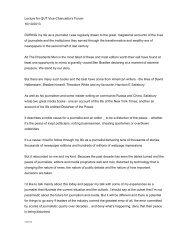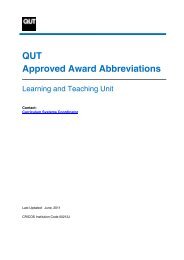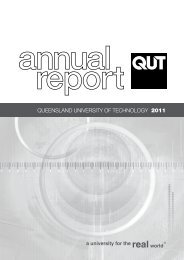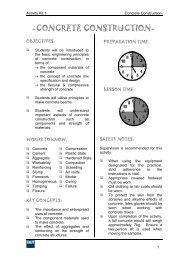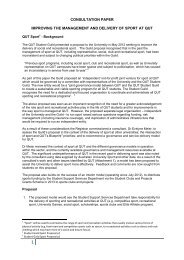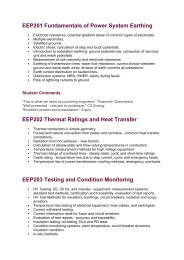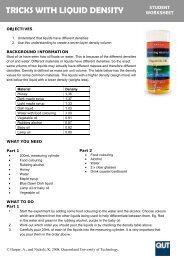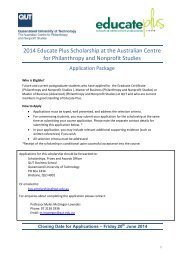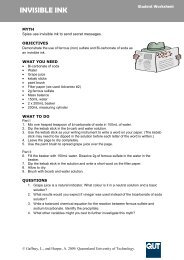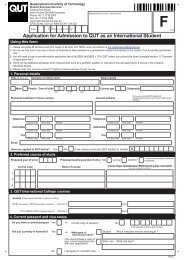You also want an ePaper? Increase the reach of your titles
YUMPU automatically turns print PDFs into web optimized ePapers that Google loves.
<strong>Eye</strong> <strong>Model</strong>TEACHER WORKSHEETYear Level 11-124. Cut a piece of cardboard 12cm x 18cm. Roll the cardboard into a 12cm long tube so that itis large enough to fit over the other tubes you have made. Check that the short tube youhave just made can slide on and off the longer tubes. Attach translucent film over the end ofthe tube using sticky tape. This will form your viewing screen.5. Test your model by placing the short tube over the tube with the 10cm lens. With the screentowards you, aim your tube at a poster on the wall. Slide the tubes slowly together or apartuntil the image of the poster is clear and in focus. Measure the distance from the screen tothe end of the inner tube.6. Replace the inner tube with the tube holding the 5cm lens. Adjust the tube until the imageof the poster is clear and in focus. Measure the distance from the screen to the end of theinner tube.7. Insert the 10cm focal length biconcave lens into the inner tube. Adjust the tube until theimage of the poster is clear and in focus. Measure the distance from the screen to the endof the inner tube.8. Replace the inner tube with the tube holding the 15cm lens. Adjust the tube until the imageof the poster is clear and in focus. Measure the distance from the screen to the end of theinner tube.9. Insert the 30cm focal length biconvex lens into the inner tube. Adjust the tube until theimage of the poster is clear and in focus. Measure the distance from the screen to the endof the inner tube.CALCULATIONS1. Calculate the focal length of each lens and lens combination.Focal length = length from screen to tip – length of inner tube(14cm) + 5cm.2. Calculate the percentage error between the measured and given values of focal length forthe single lenses.Percentage error = ((f measured - f literature )/f measured )x1003. Calculate the height of the image produced from the biconvex 10cm focal length lens.Height image =(height object x distance image )/distance objectQUESTIONS1. What effect did adding the second lens to the 5cm focal length lens have on the combinedfocal length? What effect did the second lens have on the 15cm focal length lens? Addingthe second lenses corrected the focal lengths to 10cm.2. What sort of eye problem was modelled using the 5cm focal length lens? Myopia –nearsightedness when a distant object focuses in front of the retina and a concave lens isrequired for correction.3. What sort of eye problem was modelled using the 15cm focal length lens? Hyperopia –farsightedness when a near object focuses behind the retina and a convex lens is requiredfor correction.Is the image projected on the screen right side up or upside down? Explain. The image isupside down. This is because the distance to the object we are viewing is more than thefocal length of the lens. When the rays from the top of the object pass through the lens theyare refracted such that they travel further and become the bottom of the image. The raysfrom the bottom of the object refract through the lens such that they become the top of theimage. See diagram:© Harper, A., Isoardi, G. and Nickels, K. 2008. Queensland University of Technology.
<strong>Eye</strong> <strong>Model</strong>TEACHER WORKSHEETYear Level 11-124. Is the image real or virtual? Explain. The image is real because it can be seen on a screenplaced at the point where the image forms.5. Photocopy machines typically produce an inverted image. What would be necessary tomake a photocopier produce an upright image? Photocopy machines typically produce aninverted image. What would be necessary to make a photocopier produce an uprightimage? You would need to use another convex lens to re-invert the image so it becomesupright. The original image would need to be placed at the focal length of the lens so thatthe upright image was exactly the same size.EXTENSION1. Give students the biconvex lenses (5, 10 and 15cm) without telling them the focal lengths.Ask students to determine the focal lengths and calculate the corrective lenses needed tomake all focal lengths 10cm.REAL WORLD APPLICATIONSRefracting Telescopes: Refracting telescopes use three lenses in series. The objective lens islarge, to collect as much light as possible. It produces a reduced, inverted image, which asecond lens reinverts. Finally the eyepiece creates an enlarged virtual image of this uprightimage.Burnt plant leaves: Broad-leafed plants may burn if watered on a hot day. The droplets ofwater act as lenses to focus the sun’s rays onto cells in the plant leaves.Compound microscope: The compound microscope uses an objective lens to produce anenlarged real image. The image is then magnified as a virtual image by the eyepiece.CURRICULUMPhysics Senior SyllabusOrganiser 2: EnergyE1: Energy may take different forms originating from forces between, or relative motion of, particlesor objects.E1.6: Physicists use models to explain and reconcile observed energy phenomenaE3: Energy transfer processes provide us with different ways of using and dealing with energy andradiation and these have different social consequences and applications.RESOURCES1. Elsaeed, R. (ed.) (2003). 150 Great Science Experiments. Annes Publishing Ltd: London.2. Alaska <strong>Eye</strong> Care Centers. How does the eye work? Retrieved 5 September, 2008,from http://www.alaskaeyecare.com/visualsystem.cfm3. Lenses purchased from Livingstone International.© Harper, A., Isoardi, G. and Nickels, K. 2008. Queensland University of Technology.



